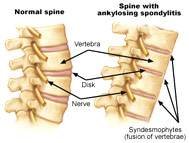Spondylosis is spinal degeneration and deformity of the joint(s) of two or more vertebrae that commonly occurs with aging. Often there is herniation of the nucleus pulposus of one or more intervertebral discs and/or formation of osteophytes.
|
|

|
 |
When the space between two adjacent vertebrae narrows, leading to compression of a nerve root emerging from the spinal cord may result in radiculopathy (sensory system and motor system disturbances, such as severe pain in the neck, shoulder, arm, back, and/or leg, accompanied by muscular weakness). Less commonly, direct pressure on the spinal cord (typically in the cervical spine) may result in global weakness, gait dysfunction, loss of balance, and loss of bowel and/or bladder control. The patient may experience a phenomenon of shocks in hands and legs because of nerves contraction and lack of blood flow. If vertebrae of the neck are involved it is labeled Cervical Spondylosis. Lower back spondylosis is labeled Lumbar Spondylosis.
Symptoms
Severe pain in the neck, shoulder, arm, back, and/or leg, accompanied by muscular weakness.
Homoeopathic Approach:
Brings about relief in symptoms:
Helps in relieving symptoms like stiffness pain and increases joint mobility.
Controls and cures the underlying disease process:
It helps in controlling the disease processes by providing strength to the adjoining ligaments and curing the degenerative process thus helping in maintaining the joint space leading to relief in symptoms and curing the disease. In certain cases were the degenerative processes has led to severe disease conditions in such cases homoeopathy can offer excellent palliative treatment.
|
|
Click
here for Case
Studies |
|
|





